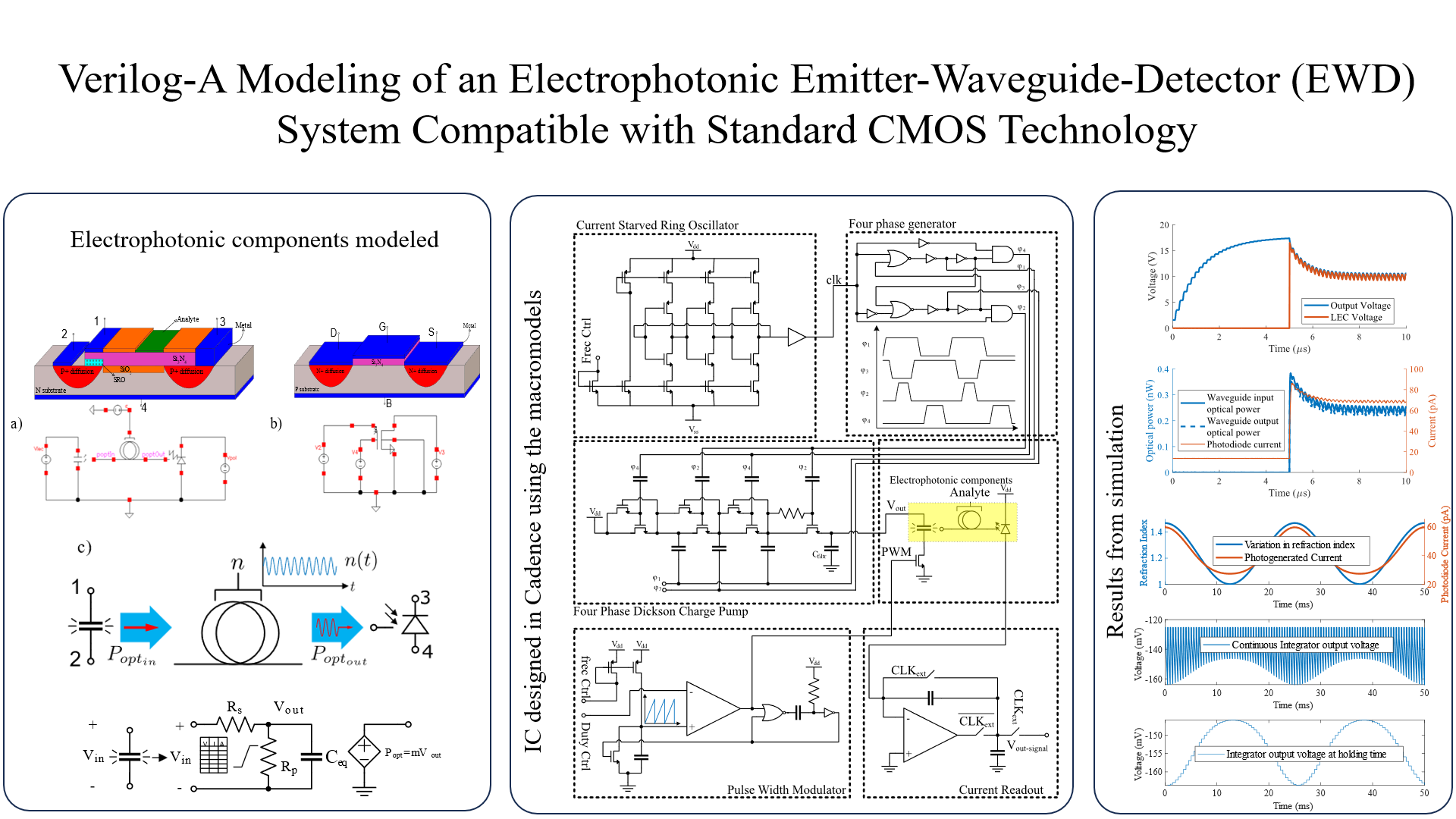Verilog-A Modeling of an Electrophotonic Emitter-Waveguide-Detector (EWD) System Compatible with Standard CMOS Technology
Keywords:
electrophotonic, OEIC, Light Emitting Capacitor (LEC), modeling, Verilog-AAbstract
Lab-On-A-Chip (LOC) devices that utilize light-based detection principles offer advantages compared with their electronic counterparts, such as higher sensitivity and not necessarily needing markers, simplifying their use, and reducing reagent consumption. Recently, the development of Si-based light emitters compatible with standard CMOS manufacturing processes has overcome one of the main obstacles in creating fully integrated electrophotonic systems on the same substrate. This groundbreaking achievement means the possibility of integrating photonic and driving circuitry in the same chip. However, due to its extreme novelty and specific electronic requirements, new design solutions must be tailored to further aid fulfilling the promise of a fully integrated electrophotonic system. The lack of existing circuit design models and tools hinders the advancement of this technology. To aid further in designing these systems, this article presents the development of a Verilog-A macromodel for an electrophotonic circuit composed of a Light Emitting Capacitor (LEC), a waveguide, and a sensor. The system was simulated in the Cadence Virtuoso environment, and a use case exhibits the system simulation including a CMOS circuit for emitter excitation and sensor reading.
Downloads
References
A. A. González-Fernández, W. W. Hernández-Montero, J. Hernández-Betanzos, C. Domínguez, and M. Aceves-Mijares, “Refractive index sensing using a Si-based light source embedded in a fully integrated monolithic transceiver,” AIP Adv., vol. 9, no. 12, p. 125215, Dec. 2019.
E. Luan, H. Shoman, D. M. Ratner, K. C. Cheung, and L. Chrostowski, “Silicon Photonic Biosensors Using Label-Free Detection,” Sensors (Basel)., vol. 18, no. 10, p. 3519., Oct. 2018.
A. A. González-Fernández, J. Juvert, M. Aceves-Mijares, and C. Domínguez, “Monolithic Integration of a Silicon-Based Photonic Transceiver in a CMOS Process,” IEEE Photonics J., vol. 8, no. 1, 2016.
M. Aceves-Mijares et al., “On the origin of light emission in silicon rich oxide obtained by low-pressure chemical vapor deposition,” J. Nanomater., vol. 2012, 2012.
X. Fan, I. M. White, S. I. Shopova, H. Zhu, J. D. Suter, and Y. Sun, “Sensitive optical biosensors for unlabeled targets: a review.,” Anal. Chim. Acta, vol. 620, no. 1–2, pp. 8–26, Jul. 2008.
G. R. Proll and O. S. Narayanaswamy, “Optical Sensors: Industrial, Environmental and Diagnostic Applications,” Anal. Bioanal. Chem., vol. 381, no. 1, 2005.
C. AB, “COMSOL Multiphysics® v. 5.6.” Stockholm, Sweden.
Ansys Lumerical, “FDTD Solutions.” 2023.
Ansys Lumerical Lumerical, “INTERCONNECT.” 2023.
M. S. Salem, G. M. Naser, and A. A. El-Gamal, “Dielectric response and transport properties of silicon films nano-textured by random voids,” J. Mater. Sci. Mater. Electron., vol. 31, no. 22, pp. 19883–19894, 2020.
S. M. Sze, Semiconductor devices : physics and technology. New York, NY: Wiley, 2012.
L. Desmarais, Applied Electro-Optics, 1st ed. Prentice Hall, 1998.
A. A. González-Fernández, M. Aceves-Mijares, O. Pérez-Díaz, J. Hernández-Betanzos, and C. Domínguez, “Embedded Silicon Nanoparticles as Enabler of a Novel CMOS-Compatible Fully Integrated Silicon Photonics Platform,” Crystals, vol. 11, no. 6, 2021.
A. A. González Fernández, “Studies and integration of Silicon-based light emitting systems,” Universitat de Barcelona, 2014.
F. O. Coy, A. Díaz-Méndez, M. Aceves-Mijares, A. A. González-Fernández, and V. R. G. Diaz, “CMOS design of the power and modulation stage for a light emitting capacitor (LEC),” in 2019 16th International Conference on Electrical Engineering, Computing Science and Automatic Control (CCE), 2019, pp. 1–5.
J. F. Dickson, “On-chip high-voltage generation in MNOS integrated circuits using an improved voltage multiplier technique,” IEEE J. Solid-State Circuits, vol. 11, no. 3, pp. 374–378, 1976.


